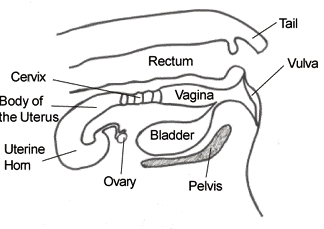
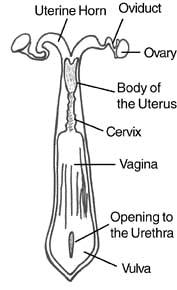
anatomy and physiology | estrus synchronization | male reproduction | management issues | expected progeny difference (epd) | index scores | breeding soundness evaluation (bse)
Introduction:
The difference between a successful operation and one that struggles is often the number of healthy newborns produced in a given year. Obviously, more lambs/kids mean more income. The challenge is trying to manage all the possible influences that can affect the reproductive health of a given flock/herd. Each of the following play a role in reproductive health:The information that follows will give the producer a basic background in small ruminant reproduction and physiology, and then identify the major management issues that need to be considered when evaluating reproductive health.
Anatomy and Physiology:
Female Reproductive System
 |
 |
Terms:
Male Reproductive System
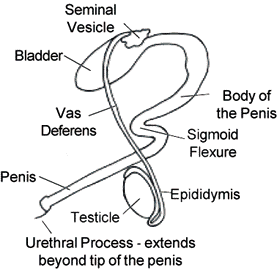
Terms
:Both Male and Female
:The reproductive stages and cycles in sheep and goats are summarized in the following tables and descriptions:
Table 1 - Female:
| Species | Age when puberty reached | *Breeding season | Estrous cycle length | **Amount of time in estrus | Time when ovulation occurs | Time that corpus luteum (CL) must be present to maintain pregnancy | Gestation length |
| Ewe | 6-12 months |
Seasonally polyestrus (July to March) |
16-17 days | 18-36 hours | 24 hours after the onset of estrus | Throughout pregnancy | 144-153 days(147 ave.) |
| Doe | 4-12 months |
Seasonally polyestrus (Sept to January) |
20-22 days | 18-36 hours | 12-36 hours after the onset of estrus | Throughout pregnancy | 146-151 days(150 ave.) |
* Some breeds and animals that live in warmer climates may cycle year round.
** Some ewes and does do not show obvious signs of estrus unless a male is
present.
Table 2 - Male:
| Species | Age when puberty reached | Breeding season | Type of penis | Volume of semen per ejaculation | Total sperm per ejaculation | Length of time for new sperm to mature (spermatogenesis) |
| Ram | 4-12 months(6 mo. ave.) | Non-seasonal (will breed anytime) | Fibroelastic with a sigmoid flexure and obvious urethral process | 0.7-2 mLs (1 mL ave.) | 2-11 billion (3 billion ave.) | 59-73 days |
| Buck | 2-8 months | Non-seasonal (will breed anytime) | Fibroelastic with a sigmoid flexure and obvious urethral process | 0.8 mLs | 4 billion | 60-70 days |
Female Reproduction:
In a simplified overview, GnRH is released by the hypothalamus, causing the pituitary to produce FSH. The FSH stimulates the ovary to begin to develop a follicle. As the follicle matures, estrogen is secreted by the follicle and the pituitary is stimulated to produce increased amounts of LH. This increase in LH (LH surge) causes final maturation of the follicle and ovulation of the egg or ovum. Once a follicle has ovulated, it fills with blood and becomes a corpus hemorrhagicum. The corpus hemorrhagicum becomes a corpus luteum (CL) when the tissues/cells of the ruptured follicle and ovary begin to produce progesterone instead of estrogen. This process of forming a CL is called luteinization. Progesterone has a negative feedback
on GnRH production.It is is now time for the body to determine if a successful pregnancy has occurred. If the egg or ovum is not fertilized, the female must deteriorate or regress the CL. This is accomplished by the release of prostaglandin F2a (PGF2a) from the uterus. The PGF2a causes regression (loss) of the CL or luteolysis. In the pregnant female, the fertilized embryo prohibits the release of PGF2a by the uterus. This leaves the CL fully functional and able to produce progesterone necessary for the pregnancy to be maintained.
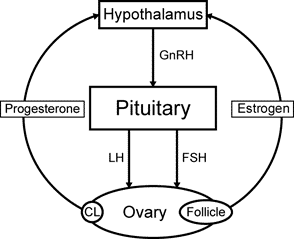
Estrus Synchronization:
With an understanding of the physiology and related hormones, a discussion of the various hormones used to manipulate an animal’s estrous cycle can now be understood. The following information lists the common drugs used to influence an animal’s estrous cycle. Realize that NONE of these drugs are approved for use in sheep or goats and must be used in an extra-label manner. Refer to page B647 for additional information on extra-label drug use.Prostaglandin (PGF2a): Lutalyse and In-Synch (page I 495).
Melengestrol acetate (MGA) and controlled intravaginal drug-releasing devices (CIDRs): Many of the CIDRs are not available in this country.
P.G. 600 - Pregnant mare serum gonadotropin (PMSG) and human chorionic gonadotropin (hCG): PMSG acts like FSH and hCG acts like LH in the sheep or goat.
Ram or Buck Effect: Many times
one of the most powerful ways to cause females to come into estrus is by
introducing a ram or buck to the flock or herd. The females must not have had
any contact with a male for at least 4 weeks previously. This commonly induces
estrus in about 6 days. This technique can also be used after a product like
Lutalyse is given or MGA is removed from the diet.
In the tiny tubules (seminiferous tubules) of the testicle, immature sperm are produced. These sperm move to the epididymis, where they fully mature and are stored prior to ejaculation. During ejaculation, the sperm travel through the vas deferens, and into the urethra. In the vas deferens and urethra, additional fluids from the secondary sex glands (seminal vesicles, prostate, bulbourethral glands) are added that help keep the sperm alive.
Sperm are very sensitive to extremes in heat or cold (temperatures above 90°
F or below 15° F). Animals that are sick, have a fever, or are fat (causing
insulation for the sperm) often have lower numbers of healthy sperm. Severe
cold, heat, stress, and pain also cause decreased numbers of normal sperm.
Because it takes at least 60 days for sperm to completely mature, many of these
changes to the sperm are not seen until 60 days after the injury/insult.
Reproduction Related Management Issues:
The decision on what animals to use or keep as replacements is a critical one. The animal’s reproductive performance, milk production potential, and mature size should match environmental conditions and producer goals. Production efficiency and profitability can be maximized by correctly matching the biological type of the animal with the available feed resources, labor, weather and other environmental factors. Accurately identifying rams/bucks and ewes/does that excel in these areas is the key to a successful selection program. When comparing animals, realize that less than half of the physical characteristics that can be seen visually are due to genetic differences. The remaining (over half) characteristics observed visually are due to what geneticists refer to as environmental differences. For example, if gain is measured on a number of different lambs that were fed and treated the same, they will not all gain the same amount; this is a genetic influence. However, if twins are placed on feed where one is fed only hay and the other only creep feed, they will not gain the same amount; this is an environmental influence. So, in order to change performance there are two choices: change environment or change genetics. Changing environment or management can have a huge impact on many traits; however, management changes are only evident as long as the new practice is continued.Because the decision to buy/cull/keep an animal is difficult and at the same time very important, it should be based on sound statistical information. This information can come from the National Sheep Improvement Program (NSIP) and Expected Progeny Difference (EPDs). It can come from records kept by the farm or ranch itself (index scores and visual appraisals) and from a reproductive evaluation/breeding soundness evaluation (BSE) performed by a veterinarian or other professional. Evaluating reproductive ability is best done by utilizing a combination of EPDs, farm records (index scores and visual appraisals), and BSEs. The following will discuss these methods of evaluating reproductive ability and give suggestions on how to apply the results. Most of the following information will focus on the sheep industry where EPDs and reproductive information is readily available. The dairy goat industry does have reproductive statistics in the form of predicted transmitting abilities (PTAs), linear scores, and heritability for milk yield, milk fat and protein content, and physical traits.
Ram and Buck Selection:
An individual breeding male will be mated to many females, making the selection of a ram or buck particularly important. The purchase of rams or bucks should be made from breeders of testing organizations or participants of performance records, like the National Sheep Improvement Program (NSIP). Records on each sire purchased should include immunization status, flock/herd health management procedures, and a medical history. Fertility evaluation (testicular size and spermatozoa quality) should be part of the selection criteria.
Expected Progeny Difference (EPD)
Expected Progeny Difference (EPD):
The term Expected Progeny Difference (EPD) is a measure of the expected difference in traits the offspring from one sire or dam will have when compared to others in the same breed. EPDs are summations of genetic information taken from animals of the same breed, but found in many different flocks. EPD values are expressed as plus or minus values in units appropriate for each trait. For example, a ram with a number-born EPD of +.10 means that the progeny of that animal on average will have .1 more lambs than the average animal. This means that if the average ewe in a particular flock would have 1.9 lambs per lambing, then this ram would produce ewes that have 2.0 lambs per lambing. These may sound like very small numbers unless flock calculations using the new ram’s number-born EPD are performed. For example, a flock with 200 ewes lambing will have 20 additional lambs from the offspring of the ram with a +.1 number-born EPD. This translates to $2,000 extra dollars if the additional lambs are sold at $100 a piece. It is important to understand that maternal traits take a generation longer to be expressed than growth traits. For example, if a ram is purchased that will improve numbers born, the ewes that he is bred to will not have more lambs. It is his daughters that are kept back in the flock that will have more lambs. Producers can receive EPDs for weight gain traits, milking, mothering ability to weaning, number born and reared to weaning, yearling performance, and wool traits. Realize that certain traits (carcass traits) are easily passed on from parent to offspring or have a high heritability. Others are difficult to pass on (reproductive and maternal traits) and have a low heritability. Traits that have a low heritability are highly affected by environment or management.Utilization of EPD Values: To use EPDs effectively, it must be known what changes in the flock need to be made and what things should stay the same. For example, should the lambs be born bigger or smaller, gain faster, or have more muscle? Should the ewes have triplets instead of twins?
EPDs are a useful tool to change specific traits. It is difficult and usually impossible to find animals that are exceptional for all traits. Tables are available listing the range of EPD values for each trait and breed. These tables provide the information needed to determine whether the animal is in the top 25% for the trait for the breed or the top 1%. The EPDs cannot be used across different breeds since each breed has a different average for the trait.
Another item to consider when evaluating EPDs is the accuracy or reliability of the EPD values. Accuracy is an indication of how much information was available to evaluate the trait for an animal. Accuracy levels range from 0% to 99%. The higher the number, the more reliable the sire or dam will produce the indicated EPD in the traits of their offspring.
One important thing to realize is that genetics are variable. For example, a ram with a gain EPD of +1.5 kg is purchased and the ewe that he is mated to has a gain EPD of -.5 kg. The average performance of the progeny will be +1.0 kg more than the offspring of a ram that had a gain EPD of 0. However, because of the variability of genetics, some progeny will be quite a bit better than +1.0 and some will be quite a bit lower.
Using EPDs in Sheep Production: The following information identifies specific considerations that must be made depending on the type of sheep production system the producer is trying to establish. The information on A270 will help identify the various sheep production systems.
Example: A particular producer would like to increase the number of lambs weaned per ewe in his flock. To do this he decides to purchase a ram with a EPD of +.3 lambs weaned. He plans on keeping 40 ewe lambs sired by the new ram. His current ewe flock has an average EPD of 0 for number of lambs weaned. The producer should expect 6 additional lambs weaned the first year the ewe lambs sired by the new ram give birth. This number is calculated using the following equations:
An estimate of the average EPD for the ewe lambs kept can be calculated by adding the EPD for lambs weaned for the ewes currently in his flock to the EPD for the new ram. Then divide this number by two (representing sire and dam).
(+ 0 and +.3) / 2 = +.15 lambs weaned
The number of additional lambs weaned can be calculated by multiplying the total number of new replacement ewes that will be kept, by their newly calculated EPD.
40 x +.15 = 6 additional lambs weaned
If lambs are worth $100, there is a potential of $600 additional revenue every time the replacements give birth.
Index Scores vs EPDs:
Index scores are ways to compare animals within a flock/herd. Unlike EPDs, they are based solely on the animal’s own performance record for that lambing or kidding, and do not relate to animals in other groups or flocks/herds.Adjusted 120-Day Weights: Traits that are commonly used to evaluate an individual animal’s performance include milk production, weaning weights, size for age, etc. However, because of several variables (sex of the animal, type of birth, type of rearing, age of dam, etc.), raw weaning data (weaning weights) is of little use in its unadjusted form. For example, the 120-day weight of one lamb cannot be compared to the 90-day weight of another. The weaning weight of a twin cannot be compared to that of a single. A ewe lamb is expected to be lighter than her full sibling wether. Lambs produced and raised by either immature ewes or aged ewes are expected to be lighter than those from middle-aged ewes. Because these differences are apparent in the average weaning data, it is necessary to adjust or standardize the data. By doing this, it becomes possible to equally compare the production of one animal to another. The most commonly accepted method to standardize weaning weights is the adjusted 120-day weight. In sheep the standard to which all other animals are compared is a single 120-day old ewe lamb born and raised by a middle-aged ewe.
Calculating the Adjusted 120-Day Weight: To accomplish this, the lamb’s actual daily rate of gain must be determined. This is done by taking the lamb’s actual weaning weight (WNWT) and subtracting the birth weight (BWT). This is the total weight gained by the lamb during the suckling period. Next, divide the age of the lamb in days into this gain to yield average daily gain (ADG). Then multiply this ADG by 120 days and add back the birth weight (BWT). This weight is an estimate of what the lamb would weigh at 120 days.
Example:
To determine the adjusted 120-day weight of a lamb weaned at 80 days with a WNWT of 60 lbs. and a BWT of 8 lbs., use the following equations:60 - 8 = 52 lbs. gained during the suckling periodADG = WNWT - BWT / Age in Days
Adj. 120-Day Weight = ADG X 120 + BWT
Other adjustments may need to be made to account for other situations that may be unique for this lamb. These include adjustments for sex of the lamb, age of the dam, type of birth, and type of rearing. These adjustment factors are standardized and are available from most Cooperative Extension Service agents and agricultural colleges and universities. The standardized sheep adjustment factors are contained below:
| Adjustment Factors for Sheep | Age of Dam | ||
| 1 year old | 2 yrs or over 6 yrs old | 3 to 6 yrs old | |
| Ewe Lamb | |||
| • Single | 1.22 | 1.09 | 1.00 |
| Twin-raised as twin | 1.33 | 1.20 | 1.11 |
| • Twin-raised as single | 1.28 | 1.14 | 1.05 |
| • Triplet-raised as triplet | 1.46 | 1.33 | 1.22 |
| • Triplet-raised as twin | 1.42 | 1.28 | 1.17 |
| • Triplet-raised as single | 1.36 | 1.21 | 1.11 |
| Wether Lamb | |||
| • Single | 1.19 | 1.06 | 0.97 |
| • Twin-raised as twin | 1.30 | 1.17 | 1.08 |
| • Twin-raised as single | 1.25 | 1.11 | 1.02 |
| • Triplet-raised as triplet | 1.43 | 1.30 | 1.19 |
| • Triplet-raised as twin | 1.39 | 1.25 | 1.14 |
| • Triplet-raised as single | 1.33 | 1.18 | 1.08 |
| Ram Lamb | |||
| • Single | 1.11 | 0.98 | 0.89 |
| • Twin-raised as twin | 1.22 | 1.09 | 1.00 |
| • Twin-raised as single | 1.17 | 1.03 | 0.94 |
| • Triplet-raised as triplet | 1.35 | 1.22 | 1.11 |
| • Triplet-raised as twin | 1.31 | 1.17 | 1.06 |
| • Triplet-raised as single | 1.25 | 1.10 | 1.00 |
Source: Sheep Industry Development Program, Englewood, CO and U.S.D.A. Cooperative Extension Service
Example:
Now calculate the adjusted 120-day weaning weight of the same lamb, but this time use the appropriate adjustment factor taken from the above table. This lamb is a twin, born and reared, ram lamb from a 1-year old ewe. Again, this lamb weighed 60 pounds at 80 days of age. This time use the following for the second equation:Adj. 120-day Wt. = ADG x 120 x Adjustment Factor + BWT
60 - 8 = 52 lbs. gained during
the suckling period
52 / 80 = 0.65 lbs. ADG
0.65 X 120 X 1.22 + 8 = 103 lbs. adjusted 120-day weight
Conclusion: The second example more accurately calculates the lamb’s adjusted 120-day weight because it accounts for the sex of the lamb, age of the dam, type of birth, and type of rearing.
Flock/Herd or Group Averages:
After a fully adjusted 120-day weaning weight for all offspring produced by each mother in a flock/herd has been calculated, then an average adjusted weight for the entire flock/herd or groups of animals within the flock/herd can be calculated. These are calculated by adding up the total adjusted 120-day weights for all the offspring in the flock/herd or a specific group and dividing that number by the number of animals that were added together. For example, five ram lambs had the following adjusted 120-day weights: 118, 120, 111, 85, and 95. Added together and divided by 5, this gives an average 120-day adjusted weight of 105.8 for this group of ram lambs.(118 + 120 + 111 + 93 + 95) / 5 = 107.4 ave. 120-day adj. wt. for the group
Index Scores:
After a flock/herd or group average has been calculated, index scores can be calculated for adjusted 120-day weight, yearling weight per day of age, and visual appraisal scorecards. Index numbers reflect how far above or below the average of the flock/herd a particular animal ranks. Using index scores also permit the producer to compare one year’s production to another (assuming that the effects of different environmental conditions have been essentially eliminated). These index scores and flock/herd averages allow a breeder to more accurately assess progress over a period of years or how one sire verses another sire used in previous years may be influencing production. To calculate an index score, simply divide each individual animal’s weight or appraisal by the flock/herd or group average and multiply that number by 100.Example:
Ram lambs with ear tag #s 1255 and 1267 had adjusted 120-day weights of 120 and 95. These are two of the five rams from above.#1255: 120 divided by 107.4 (the ram lamb group ave.) X 100 = 111.7
#1267: 95 divided by 107.4 (the ram lamb group ave.) X 100 = 88.4
Conclusion: Based on the average adj. 120-day wt. (107.4) for this group of rams, lamb #1255 is above average and ram #1267 is below average.
Yearling Weight-Per-Day-of-Age: Weight-per-day-of-age (WDA) is measured when the animal is about 250 days of age or older. It is a good estimate of inherent potential to grow. The yearling weight-per-day-of-age index is calculated similar to the adjusted 120-day weight index except that birth weights and adjustment factors are not utilized. The yearling weight-per-day-of-age is calculated by dividing the animal’s current weight by the number of days old the animals is on the weigh day. This yields the weight-per-day-of-age (WDA). The WDA is then converted to an index format by dividing each individual’s WDA by the group average and then multiplying by 100. Realize that group averages must be calculated beforehand in the same manner that the adjusted 120-day weight averages were figured.
Example: The average WDA for a particular group of ram lambs is determined to be 0.84. A yearling WDA for a 150 lb. ram lamb that is 250 days old is calculated as follows:
150 / 250 = 0.6 WDA
0.6 / 0.84 X 100 = 71.4 index score
Conclusion: The index score for this ram lamb (74.4) is below the average of the rest of the ram lambs in this group and he should be considered for possible sale.
The Visual Appraisal Scorecard: The visual appraisal scorecard is an approach that any producer of sheep or goats may implement with their flocks or herds. This approach allows the careful consideration of individual traits that are necessary in planning constructive matings. Animals can be evaluated and visually scored on the below characteristics. A total visual appraisal score is then figured and can be placed into an index format in the same manner used for the adjusted 120-day weight and the yearling weight-per-day-of-age, etc. The animal can then be compared to others in the flock/herd or other animals that are being considered for purchase. A sample scorecard is found below:
| Scorecard for Grading Rams | Scorecard for Grading Ewes | ||
| Trait | Value | Trait | Value |
| General Appearance | General Appearance | ||
| Frame, scale, height, length | 1 - 10 | Weight and scale for age | 1 - 10 |
| Muscling, body thickness, leg development | 1 - 10 | ||
| Structural Soundness | Structural Soundness | ||
| Balance | 1 - 10 | Bone, feet and legs | 1 - 10 |
| Bone, feet and legs | 1 - 10 | ||
| Breed-Type and Sex Character | Breed-Type and Sex Character | ||
| Head and color appropriate for breed | 1 - 10 | Wool grade | 1 - 10 |
| Fleece uniformity | 1 - 10 | ||
| Facial covering and wrinkling | 1 - 10 | ||
| Total Score: | 00 / 50 | Total Score: | 00 / 50 |
Combined Selection Index: Each of the three example trait indexes
illustrated previously in this discussion (adjusted 120-day weight, yearling
weight per day of age, and visual appraisal scorecard) may be combined into a
single selection index. A producer can custom fit the combined index for his/her
own flock/herd standards and breed characteristics. The combined index takes the
traits shown previously and applies a weighted value to each trait according to
the producer’s breeding program. For example, if a producer is of the opinion
that "visual appraisal" is the more important of the three shown, that
index may be weighted more than the 1/3 or 33.3 percent. Then the weighted
values for the other two indexes would be reduced accordingly so that the
combined weighted index would still add up to 100 percent. A relative weighted
percentage value is then calculated and combined into an overall weighted index.
The weighted index shown below is based on the three traits illustrated in this
section, but additional traits can be added or less than three may be
incorporated. In order to make rapid progress by using these selection
techniques, the heritability of the traits utilized should be moderate to high.
The indexes shown in this section were done for rams; ewe, buck, and doe indexes
can also be constructed.
Example of a Combined Selection Index:
| Ram Ear Tag # | Adj 120 Day Weight Index | Yearling Weight-Per-Day of Age Index | Visual Score Index | Combined Weighted Index |
| 1354 | 118 x 1/3 = 39 | 89 x 1/3 = 29 | 125 x 1/3 = 41 | 109 |
| 1255 | 120 x 1/3 = 40 | 99 x 1/3 = 33 | 122 x 1/3 = 40 | 113 |
| 1234 | 111 x 1/3 = 37 | 120 x 1/3 = 40 | 96 x 1/3 = 32 | 109 |
| 1444 | 93 x 1/3 = 31 | 103 x 1/3 = 34 | 106 x 1/3 = 35 | 100 |
| 1267 | 95 x 1/3 = 31 | 103 x 1/3 = 34 | 100 x 1/3 = 33 | 98 |
: Based on the combined weighted index for this group of rams, ram #1255 is above average and ram #1267 is below average. These same rams were also above and below average when the adjusted 120-day weight index was calculated.Conclusion
The Breeding Soundness Evaluation (BSE):
A breeding soundness evaluation (BSE) should be performed on every animal that is brought into a flock/herd or is kept to be a replacement. This exam is essential for all rams/bucks. A complete breeding soundness evaluation (BSE) includes a thorough physical and conformational examination, plus an ELISA test for Brucella ovis (for rams) within 30 days of purchase. Purchased animals, regardless of the source, should be isolated for an observation period of 30 days prior to introduction into the flock.
Male Breeding Soundness Evaluation (BSE):
Sperm Cells: Poor semen quality (left) and good semen quality (right).
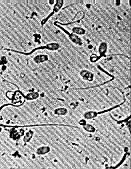 |
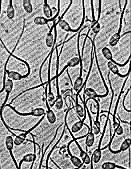 |
Prediction of Ram/Buck Performance: The job of the male is to get females pregnant. In order to do this, a sire needs a high sex-drive and serving ability, as well as a good supply of semen. Therefore, predicting the potential mating performance of a sire involves measuring:
Use of Scrotal Circumference Tape: The testicles are pulled firmly into the lower part of the scrotum by encircling the top of the scrotum with one hand and pulling down gently on the testicles. The scrotal tape is formed into a loop and slipped over the scrotum and its contents. The tape is pulled up snugly around the greatest diameter of the scrotal contents. When weather is cold, males retract their testicles making it difficult to take proper measurements. Special care should be taken to pull the testicles into the bottom of the scrotum and eliminate any wrinkles. The thumb and fingers should be located on the side of the scrotum, rather than between the testicles. This helps to prevent separation of the testicles and an inaccurate measurement. The circumference is measured in centimeters (cm) and is read at the point where the tape crosses the small steel crossbar on the tape thumb piece.
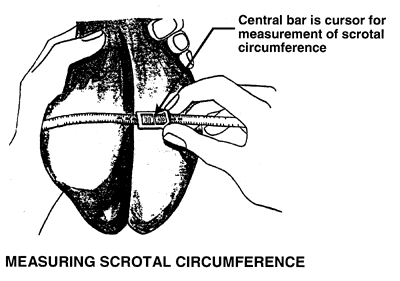
Interpretation of Results: Scrotal circumference is highly correlated to testicle size and semen production in young males. However, animal weight plays a major role in testicle size. Therefore, associating scrotal circumference with age can be misleading because of variation in weight. Despite this fact, this is still the best measurement available to determine potential semen-producing capacity in young males.
Scrotal Circumference Parameters: The following information identifies the minimum requirements for sheep breeds. (Specifics for goats have not been established.)
Ram lambs:
Yearling rams (12 to 18 months) and older:
In general, animals with a larger scrotal circumference usually have better reproductive performance. This is true for rams as well as bucks. This can be beneficial when trying to compare the breeding potential of different animals.
Based on semen evaluation and physical examination the male is classified as Satisfactory, Questionable or Unsatisfactory. All breeders from the previous year and all new males purchased or traded for breeding purposes should be examined and have a semen evaluation performed before they are turned out. Generally, a local large animal veterinarian or university extension personnel can assist with this evaluation.
If a serious infertility problem and a marked drop in conception (pregnancy)
rates does occur in a group of animals, the male should be suspected until tests
have proven otherwise.
Female Breeding Soundness Evaluation (BSE): A thorough
reproductive examination is often difficult in females because most of the
reproductive organs cannot be examined without extensive diagnostics
(ultrasound, speculum vaginal exam, etc.). Because of this, it is very important
to get a complete reproductive history. The history should include information
about estrous cycles, number of lambs/kids produced each year, and how the
female responds to the male. A general physical exam can also be performed. The
body condition, vulva, teats and udder should be evaluated. The information on
page C634 can also be used when trying to perform a physical exam.
Summary: